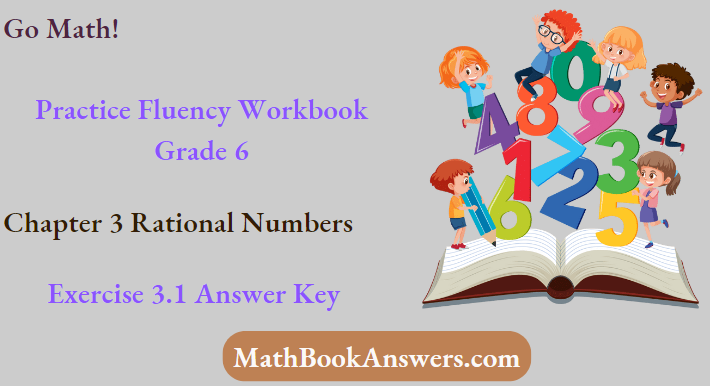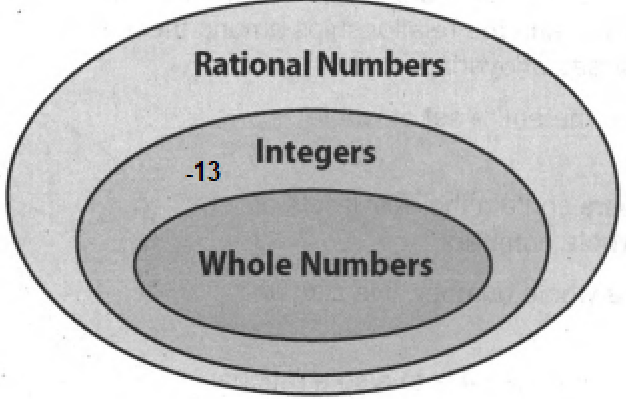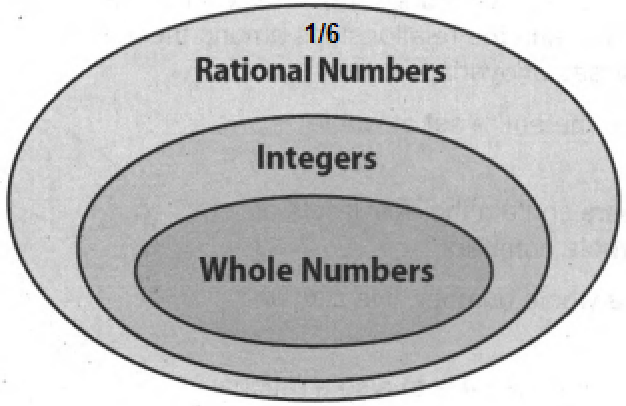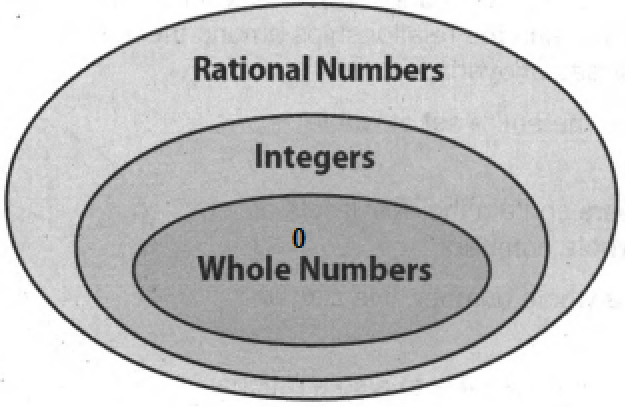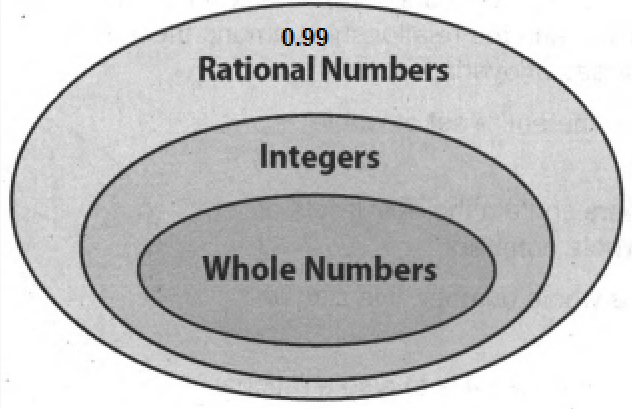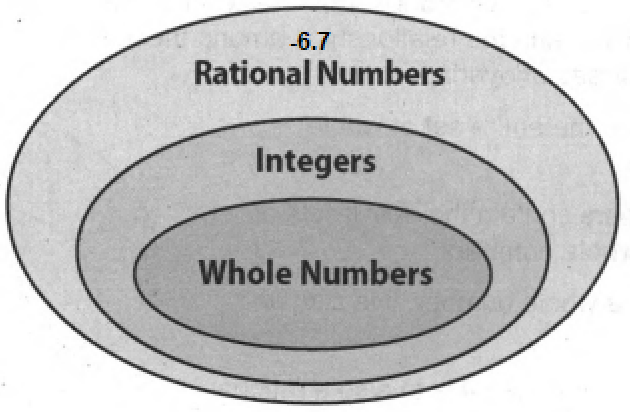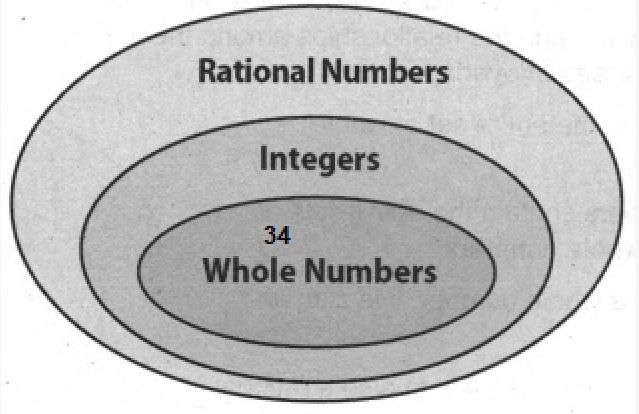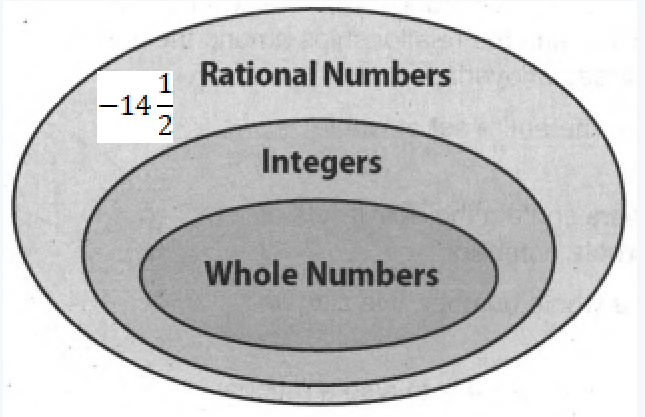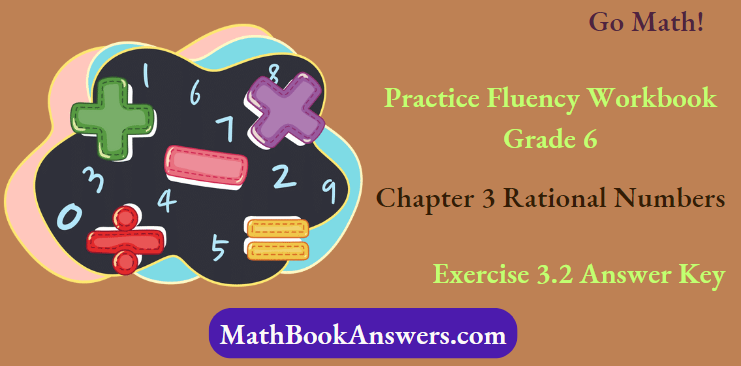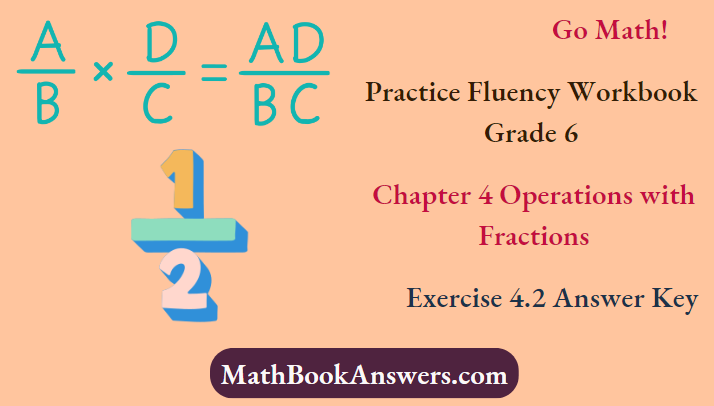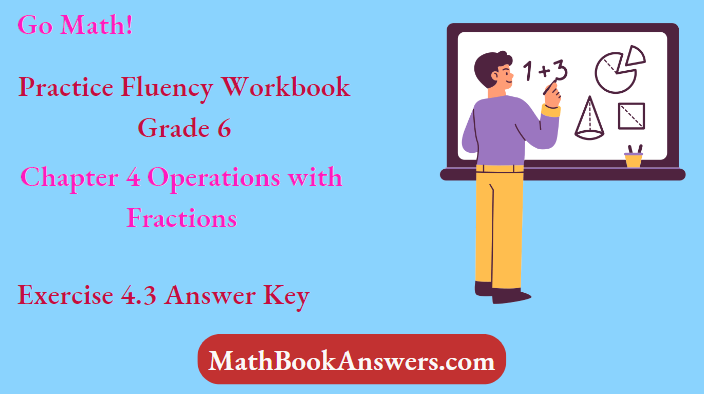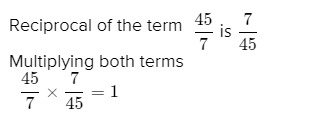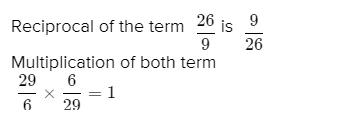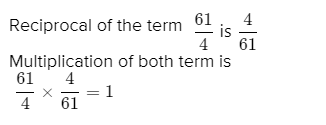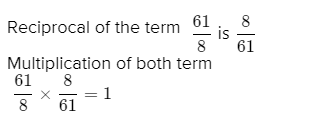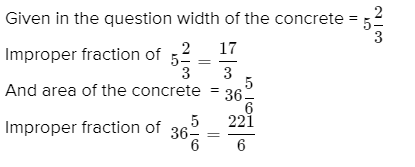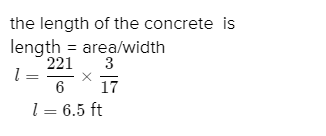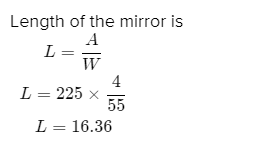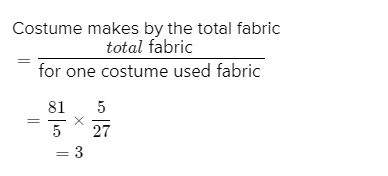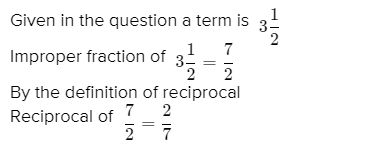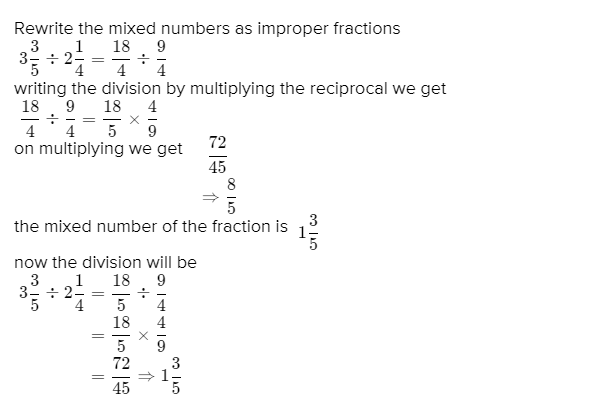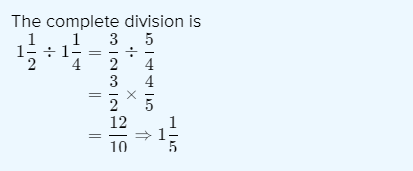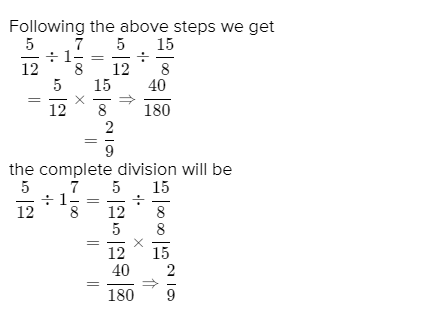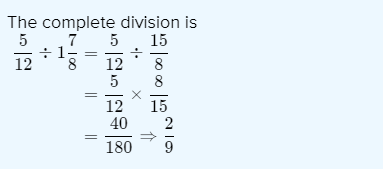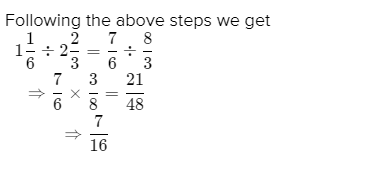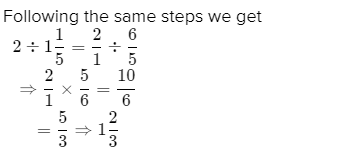Go Math! Practice Fluency Workbook Grade 6 California 1st Edition Chapter 1 Integers
Page 5 Problem 1, Answer
Given the number 6.
We need to graph the number on the number line
The number6 on the number line is shown below:
Page 5 Problem 2, Answer
Given the number 3.
We need to graph the number on the number line.
The number 3 on the number line is shown below:
Page 5 Problem 3, Answer
Given the number−3.
We need to graph the number on the number line.
The number−3 on the number line is shown below:

Go Math Grade 6 Chapter 1 Integers Exercise 1.3 Answers
Go Math! Practice Fluency Workbook Grade 6 California 1st Edition Chapter 1 Integers Page 5 Problem 4, Answer
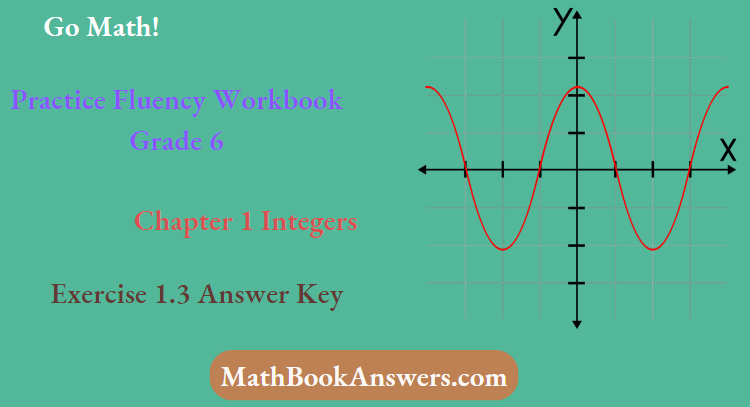
Given the number 5.
We need to graph the number on the number line.
The number on the number line is shown below:

Page 5 Problem 5, Answer
Given the number∣−6∣ .
We need to use the number line to find each absolute value.
The absolute value of∣−6∣ is 6 as shown below:

Go Math! Practice Fluency Workbook Grade 6 California 1st Edition Chapter 1 Integers Page 5 Problem 6, Answer
Given the number|3|.
We need to use the number line to find each absolute value.
The absolute value of|3|is 3 as shown below:
 Page 5 Problem 7, Answer
Page 5 Problem 7, Answer
Given the number|8| .
We need to use the number line to find each absolute value.
The absolute value of|8| is 8 as shown below:
Page 5 Problem 8, Answer
Given the number|6|.
We need to use the number line to find each absolute value.
The absolute value of |6| is 6 as shown below:
Page 5 Problem 9, Answer
Given the number∣−3∣.
We need to use the number line to find each absolute value.
The absolute value of∣−3∣ is 3 as shown below:
Go Math Grade 6 Exercise 1.3 Integers Solutions
Go Math! Practice Fluency Workbook Grade 6 California 1st Edition Chapter 1 Integers Page 5 Problem 10, Answer
Given the number|5|.
We need to use the number line to find each absolute value.
The absolute value of|5| is5 as shown below:
Page 5 Problem 11, Answer
Given the numbers6 and −6.
We need to find each absolute value and tell what do we notice.
The absolute values of 6 and −6 is shown below:
Page 5 Problem 12, Answer
Given the numbers 6 and −6 or 3 and −3.
We need to find each absolute value and tell what do we notice.
The absolute values are: We call∣−3∣ and ∣3∣ ∣−6∣ and ∣6∣ as equal numbers.
Go Math! Practice Fluency Workbook Grade 6 California 1st Edition Chapter 1 Integers Page 5 Problem 13, Answer
Given the table:

Write a negative integer to show the amount spent on each purchase on monday.
Hence the negative integer to show the amount spent on each purchase on Monday is−20.
Page 5 Problem 14, Answer
Given the table:

Write a negative integer to show the amount spent on each purchase on Tuesday.
Hence the negative integer to show the amount spent on each purchase on Tuesday is−6.
Page 5 Problem 15, Answer
Given the table:

Write a negative integer to show the amount spent on each purchase on Friday.
Hence the negative integer to show the amount spent on each purchase on Friday is−8.
Solutions For Go Math Grade 6 Chapter 1 Exercise 1.3 Integers
Go Math! Practice Fluency Workbook Grade 6 California 1st Edition Chapter 1 Integers Page 5 Problem 16, Answer
Given the table:

Find the absolute value of each transaction on Monday.
The absolute value of the transaction on Monday is20.
Page 5 Problem 17, Answer
The given table is,

We have to find the absolute value of each transaction on Tuesday.
We will take the modulus of the transaction.
The absolute value of the transaction on Tuesday is 6
Page 5 Problem 18, Answer
The given table is,

We have to find the absolute value of each transaction on Wedneday.
We will take the modulus of the transaction.
The absolute value of a payment of Wednesday is15
Go Math! Practice Fluency Workbook Grade 6 California 1st Edition Chapter 1 Integers Page 5 Problem 19, Answer
The given table is,

We have to tell on which day did Andrea spend the most on her card.
We will observe the table.
On observing the table carefully we observed that Andrea spent most on her card on Monday
Page 5 Problem 20, Answer
We have to show that, |3+10|=|3|+|10|.
We will find the value of L.H.S. and R.H.S.
We will check the values are the same or not.
Hence we showed |3+10|=|3|+|10|
Page 5 Problem 21, Answer
The given statement is How many different integers can have the same absolute value? ________ Give an example.
We have to fill in the blanks.
We will see the cases of the modulus.
The revised statement is, How many different integers can have the same absolute value? 2
Give an example. −3 and 3
Go Math! Practice Fluency Workbook Grade 6 California 1st Edition Chapter 1 Integers Page 6 Exercise 1, Answer
We have to match the absolute value of 15
The absolute value of 15 is ⇒∣15∣ ⇒15
The row C is the correct match.
Page 6 Exercise 2,Answer
We have to match the negative integer.
The negative integer is −15
The correct match is d
Page 6 Exercise 3, Answer
We have to match opposite of −7
The opposite of −7 is 7
The correct match is b
Go Math Grade 6 Integers Exercise 1.3 Key
Go Math! Practice Fluency Workbook Grade 6 California 1st Edition Chapter 1 Integers Page 6 Exercise 4,Answer
We have to match opposite of 7
The opposite of 7 is −7
The correct match is a
Page 6 Exercise5,Answer
We have to match ∣−15∣ The value of ∣−15∣ is 15
The correct match is c
Page 6 Exercise6,Answer
We have to find the value of ∣−3∣
We will use the concept of modulus.
The value of ∣−3∣ is 3
Page 6 Exercise7,Answer
We have to find the value of |5|
We will use the concept of modulus.
The value of |5| is 5
Page 6 Exercise 8, Answer
We have to find the value of ∣−7∣
We will use the concept of modulus.
The value of ∣−7∣ is 7
Go Math! Practice Fluency Workbook Grade 6 California 1st Edition Chapter 1 Integers Page 6 Exercise 9, Answer
We have to find the value of |6|
We will use the concept of modulus.
The value of |6| is 6
Page 6 Exercise 10,Answer
We have to find the value of |0|
We will use the concept of modulus.
The value of |0| is 0
Page 6 Exercise 11,Answer
We have to find the value of ∣−2∣
We will use the concept of modulus.
The value of ∣−2∣ is 2
Page 6 Exercise 12,Answer
We have to find the value of∣−10∣
We will use the concept of modulus.
The value of ∣−10∣ is 10
Go Math! Practice Fluency Workbook Grade 6 California 1st Edition Chapter 1 Integers Page 6 Exercise 13,Answer
We have to find the value of |−3/4|
We will use the concept of modulus.
The value of |−3/4| is 3/4
Page 6 Exercise 14,Answer
We have to find the value of|0.8|
We will use the concept of modulus.
The value of |0.8| is 0.8
Page 6 Exercise15, Answer
The given conditions are, Abby has been absent from class. How would I explain to her what absolute value is? Use the number line and an example in our explanation.
The absolute value of any number is its distance from 0 on the number line . Since the distance is always positive or 0 ,absolute value is positive or 0.

Detailed Answers For Go Math Grade 6 Chapter 1 Exercise 1.3
Go Math Answer Key
- Go Math! Practice Fluency Workbook Grade 6 Chapter 1: Integers Exercise 1.1 Answer Key
- Go Math! Practice Fluency Workbook Grade 6 Chapter 1: Integers Exercise 1.2 Answer Key
- Go Math! Practice Fluency Workbook Grade 6 Chapter 1: Integers Exercise 1.3 Answer Key
- Go Math! Practice Fluency Workbook Grade 6 Chapter 2: Factors and Multiples Exercise 2.1 Answer Key
- Go Math! Practice Fluency Workbook Grade 6 Chapter 2: Factors and Multiples Exercise 2.2 Answer Key
- Go Math! Practice Fluency Workbook Grade 6 Chapter 3: Rational Numbers Exercise 3.1 Answer Key
- Go Math! Practice Fluency Workbook Grade 6 Chapter 3: Rational Numbers Exercise 3.2 Answer Key
- Go Math! Practice Fluency Workbook Grade 6 Chapter 3: Rational Numbers Exercise 3.3 Answer Key
- Go Math! Practice Fluency Workbook Grade 6 Chapter 4: Operations with Fractions Exercise 4.1 Answer Key
- Go Math! Practice Fluency Workbook Grade 6 Chapter 4: Operations with Fractions Exercise 4.2 Answer Key
- Go Math! Practice Fluency Workbook Grade 6 Chapter 4: Operations with Fractions Exercise 4.3 Answer Key
- Go Math! Practice Fluency Workbook Grade 6 Chapter 4: Operations with Fractions Exercise 4.4 Answer Key
- Go Math! Practice Fluency Workbook Grade 6 Chapter 5: Operations with Decimals Exercise 5.1 Answer Key
- Go Math! Practice Fluency Workbook Grade 6 Chapter 5: Operations with Decimals Exercise 5.2 Answer Key
- Go Math! Practice Fluency Workbook Grade 6 Chapter 5: Operations with Decimals Exercise 5.3 Answer Key
- Go Math! Practice Fluency Workbook Grade 6 Chapter 5: Operations with Decimals Exercise 5.4 Answer Key
- Go Math! Practice Fluency Workbook Grade 6 Chapter 5: Operations with Decimals Exercise 5.5 Answer Key
- Go Math! Practice Fluency Workbook Grade 6 Chapter 8: Percents Exercise 8.1 Answer Key
- Go Math! Practice Fluency Workbook Grade 6 Chapter 8: Percents Exercise 8.2 Answer Key
- Go Math! Practice Fluency Workbook Grade 6 Chapter 8: Percents Exercise 8.3 Answer Key
- Go Math! Practice Fluency Workbook Grade 6, Chapter 6: Representing Ratios and Rates Exercise 6.1 Answer Key
- Go Math! Practice Fluency Workbook Grade 6, Chapter 6: Representing Ratios and Rates Exercise 6.2 Answer Key
- Go Math! Practice Fluency Workbook Grade 6, Chapter 6: Representing Ratios and Rates Exercise 6.3 Answer Key
- Go Math! Practice Fluency Workbook Grade 6, Chapter 7: Applying Ratios and Rates Exercise 7.1 Answer Key
- Go Math! Practice Fluency Workbook Grade 6, Chapter 7: Applying Ratios and Rates Exercise 7.2 Answer Key
- Go Math! Practice Fluency Workbook Grade 6, Chapter 7: Applying Ratios and Rates Exercise 7.3 Answer Key
- Go Math! Practice Fluency Workbook Grade 6, Chapter 7: Applying Ratios and Rates Exercise 7.4 Answer Key



